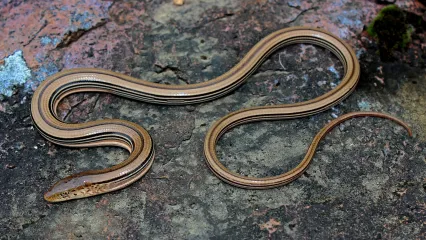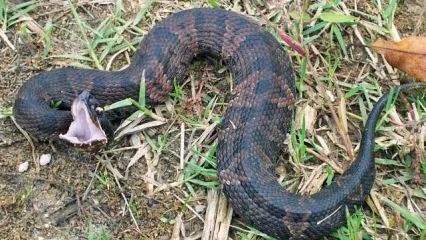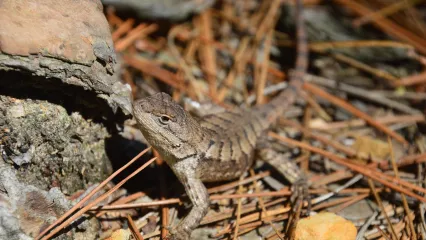
Description
Western slender glass lizards are the only Oklahoma lizards lacking limbs. They can be distinguished from all snakes by the presence of eyelids, external ear openings at the posterior end of the head, and deep folds on the lateral surfaces of the body. Juveniles and subadults are distinctly striped, with a mid-dorsal black stripe, three black stripes above the lateral fold, and two broken black stripes below the lateral folds. The underside of the body is cream-colored with no pattern. Large adults lose much of the striping on the anterior part of the body, but retain the lateral stripes on the posterior two-thirds of the body.
Size
Large adult western slender glass lizards can reach just over ten inches in snout to vent length and about 33 inches in total length. Many individuals have regenerated tails so that the ratio of tail to body length is reduced.
Habitat
Western slender glass lizards occur through much of Oklahoma, being absent from only the panhandle and the very western part of the state. In North America, the west-east distribution extends from western Kansas to central Indiana and north-south from southern Canada to southern Texas.
Life Cycle
Western slender glass lizards are strictly terrestrial and are usually associated with open grasslands. They can also be seen along roads in wooded areas. Activity occurs from April through November, depending on local climatic conditions, but peak activity occurs in mid-April to early June and then again from October to mid-November. Mating occurs in spring and females deposit clutches of 5-16 eggs in June and July. The number of eggs produced by females depends on the size of female; larger females produce more eggs than smaller females. Females remain with the eggs until they hatch in August or early September, but no post-hatching parental care exists. Hatchlings are just over 4 inches in snout to vent length. All glass lizard species are long-lived, with the capability of reaching at least nine years of age. Sexual maturity is reached during the second year following hatching. Western slender glass lizards feed primarily on invertebrates, including grasshoppers, crickets, beetles, caterpillars, spiders, and snails. As the name implies, glass lizards are fragile; when grabbed, they often appear to break in half and often one half appears to break into several pieces. The part “breaking” is the tail, which is more than half of the total length. Although many other lizards easily lose their tails when disturbed, glass lizards are most impressive in their use of this escape strategy because the tail is such a large part of the lizard. Tails contain a large amount of stored energy, and when broke, use that energy to flip around violently distracting a potential predator while the body of the lizard silently makes its escape. Tails break along cleavage plains within each tail vertebra, and segmented muscles, nerves, and blood vessels separate so that almost no blood loss occurs. Tails are regenerated and the regenerated tail is easy to distinguish from the original tail because the pattern of coloration differs. Contrary to popular belief, the lizard initiates the release of the tail, a process known as “tail autotomy.”
How To Observe
Similar to some of the skinks, particularly the Great Plains skink and southern prairie skink, western slender glass lizards are difficult to observe in the field. Most often, they are observed basking on roads in early spring or late fall.
(This profile was created by Dr. Laurie Vitt as part of a partnership between the Wildlife Department and the Sam Noble Oklahoma Museum of Natural History. It was funded as part of a larger State Wildlife Grant to survey and inventory amphibians and reptiles of the Wildlife Management Areas of Oklahoma: T-35-P-1.)


